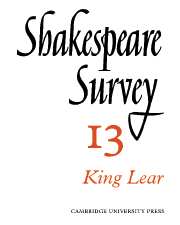Book contents
- Frontmatter
- The Catharsis of King Lear
- Lear’s Last Speech
- Albany
- Madness in King Lear
- The Influence of Gorboduc on King Lear
- Some Aspects of the Style of King Lear
- Keats and King Lear
- King Lear on the Stage: A Producer’s Reflections
- Costume in King Lear
- The Marriage-Contracts in Measure for Measure
- Tom Skelton—A Seventeenth-century Jester
- Illustrations of Social Life III: Street-Cries
- An Elizabethan Stage Drawing?
- Was there a Music-room in Shakespeare’s Globe?
- International Notes
- Shakespeare Productions in the United Kingdom: 1958
- Three Adaptations
- The Year's Contributions to Shakespearian Study 1 Critical Studies
- 2 Shakespeare’s Life, Times and Stage
- 3 Textual Studies
- Books Received
- Index
- Plate Section
Tom Skelton—A Seventeenth-century Jester
Published online by Cambridge University Press: 28 March 2007
- Frontmatter
- The Catharsis of King Lear
- Lear’s Last Speech
- Albany
- Madness in King Lear
- The Influence of Gorboduc on King Lear
- Some Aspects of the Style of King Lear
- Keats and King Lear
- King Lear on the Stage: A Producer’s Reflections
- Costume in King Lear
- The Marriage-Contracts in Measure for Measure
- Tom Skelton—A Seventeenth-century Jester
- Illustrations of Social Life III: Street-Cries
- An Elizabethan Stage Drawing?
- Was there a Music-room in Shakespeare’s Globe?
- International Notes
- Shakespeare Productions in the United Kingdom: 1958
- Three Adaptations
- The Year's Contributions to Shakespearian Study 1 Critical Studies
- 2 Shakespeare’s Life, Times and Stage
- 3 Textual Studies
- Books Received
- Index
- Plate Section
Summary
In the Elizabethan theatre, the stage fool, or clown, had an obvious, if somewhat complex, dramatic function. But in almost every other respect, study of this character bristles with difficulty. The connection between the fool and the Vice of the medieval drama remains obscure, and it is still doubtful how far the fool, the jester and the clown were distinct figures. Even if this problem is by-passed and all are treated as one, for the historian of the theatre the relationship of the court, or domestic, jester to the stage clown, the distinction between the stage fool and the court fool represented on the stage, and, not least of all, the costuming of the character in these various modes still remain open questions. To a large extent these problems arise from the fragmentary nature of the evidence and any further information which can be presented is of value.
- Type
- Chapter
- Information
- Shakespeare Survey , pp. 90 - 105Publisher: Cambridge University PressPrint publication year: 1960

